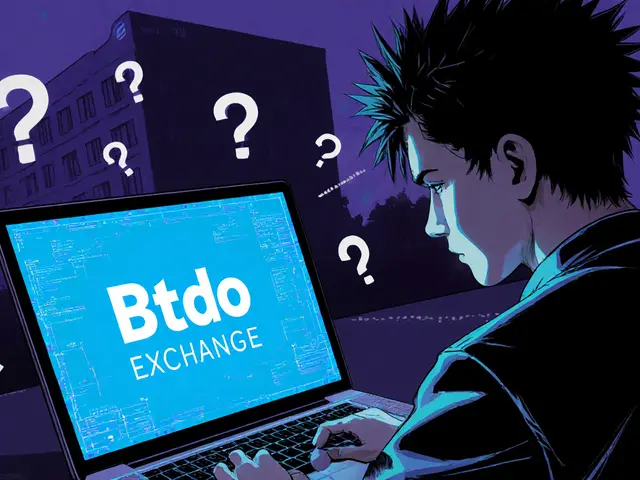OSL Crypto Exchange Fee Calculator
Estimated Trading Costs
Trading Fees
OSL charges HK$0 for all trades. No fees apply regardless of volume.
Custody Fees
OSL charges HK$0 for custody of digital assets.
When you’re hunting for a platform that can handle big crypto trades without churning out hidden fees, OSL crypto exchange pops up on many institutional radar screens. But does it live up to the hype? This review breaks down everything you need to know - from pricing and asset selection to the murky regulatory picture - so you can decide whether OSL is worth your capital.
What Is OSL?
OSL is a digital‑asset trading platform that operates under BC Group, a publicly listed technology and digital‑asset company based in Hong Kong. The exchange focuses on institutional‑grade services, offering both spot trading and over‑the‑counter (OTC) desks for large‑volume clients. OSL maintains a strong presence in Singapore, where its local branch taps into deep liquidity pools and provides intelligent Request‑for‑Quote (iRFQ) capabilities.
Asset Coverage and Trading Options
As of October2025, OSL lists more than 50 cryptocurrencies, ranging from Bitcoin and Ethereum to niche DeFi tokens. The platform supports spot trades, OTC deals, and a suite of lending and borrowing services that let users earn yields on idle assets. The iRFQ system is particularly useful for trades exceeding HK$100,000, as it generates customized price quotes based on real‑time market depth.
Fee Structure and Minimum Deposit
One of OSL’s biggest selling points is its near‑zero fee schedule. Trading fees are listed as HK$0, and custody fees are also HK$0, which is rare among exchanges that cater to high‑volume traders. However, the price of entry is steep: a minimum deposit of HK$10,000 (about US$1,280) is required before you can start trading. This threshold filters out casual retail participants and signals that OSL is targeting affluent individuals and institutional clients.
| Metric | Detail |
|---|---|
| Number of Crypto Assets | 50+ |
| Trading Fees | HK$0 |
| Custody Fees | HK$0 |
| Minimum Deposit | HK$10,000 |
| Insurance Coverage | US$1billion |
| Regulatory Status | Mixed (see below) |

Security and Insurance Coverage
OSL backs user funds with up to US$1billion in insurance - a figure that places it among the most protected crypto exchanges worldwide. While the exact policy details aren’t publicly disclosed, the coverage is intended to safeguard assets against hacking, fraud, and operational failures. In addition to insurance, OSL employs standard industry security measures such as cold‑storage wallets, multi‑factor authentication, and regular penetration testing.
Regulatory Landscape - A Mixed Bag
Regulation is where OSL’s story gets complicated. According to MoneySmart HongKong, OSL is a “listed and licensed crypto trading platform in HongKong,” suggesting it holds a local license. Meanwhile, the Singapore arm is certified by the Singapore FinTech Association and is a member of the Blockchain Association Singapore, giving it a foothold in that jurisdiction.
Contrasting these endorsements, BrokerChooser’s legal analysis claims OSL is not regulated by any top‑tier financial authority, labeling it “not considered a trusted broker.” The discrepancy means prospective users must perform their own due diligence: verify the HongKong licensing details directly with the Securities and Futures Commission, and confirm the Singapore certifications via the FinTech Association’s registry.
For clarity, we’ll treat OSL’s regulatory status as Regulatory Uncertainty - a situation where a platform has some local approvals but lacks oversight from globally recognized regulators.. This nuance is crucial when assessing risk, especially for large‑scale institutional allocations.
Trading Experience: Interface, Support, and OTC Desk
The user interface is built for power users. It offers advanced charting, order‑type granularity, and a customizable dashboard. Newcomers often describe the layout as “a bit complicated,” which aligns with feedback from WikiBit’s community reviews. The learning curve can be mitigated with OSL’s tutorial videos and a dedicated account manager for institutional accounts.
Customer support is available 24/7 via live chat and email, but response times vary. While the platform advertises round‑the‑clock assistance, some users have reported slower replies during high‑volume periods. For OTC trades, OSL promises “complete privacy and assured price quotes,” leveraging its iRFQ engine to match large orders with deep liquidity without exposing the market impact.
Lending, Borrowing, and Yield Opportunities
Beyond spot and OTC, OSL provides a lending‑borrowing marketplace. Users can lend idle crypto to earn interest rates that currently range between 3% and 12% APY, depending on the asset and market demand. Borrowers can access short‑term liquidity by posting collateral, a feature that appeals to traders looking to leverage positions without liquidating holdings.

Current Promotions (2025)
OSL is running an aggressive acquisition campaign until September302025. New accounts opened through MoneySmart receive a HK$500 gift voucher (choice of Apple Store, ParknShop, or HKTVmall) plus HK$416 in Bitcoin rewards. The tiered rewards structure looks like this:
- HK$88 for opening a new OSL account.
- HK$100 after depositing HK$10,000 and holding it for 14days.
- HK$100 for the first trade exceeding HK$100.
- Additional HK$128 in Bitcoin for trading over HK$1,000 between 15August and 30September.
These bonuses can offset the high deposit requirement, but they are only valuable if you intend to trade actively.
Account Opening - Five‑Step Process
- Email registration and verification code.
- Identity verification (government-issued ID and selfie).
- Risk and cryptocurrency‑knowledge assessment.
- Signing the client agreement and confirming the minimum deposit.
- Funding the account with at least HK$10,000.
This thorough onboarding reflects OSL’s commitment to compliance and risk management, but it also adds friction for users who prefer instant access.
Pros, Cons, and Bottom Line
Pros
- Zero trading and custody fees - a rare offering for high‑volume traders.
- US$1billion insurance coverage provides strong asset protection.
- Deep liquidity and iRFQ system ideal for large OTC deals.
- Lending‑borrowing marketplace adds yield‑generation options.
- Active promotions can offset the high entry barrier.
Cons
- Minimum deposit of HK$10,000 excludes many retail traders.
- Regulatory status is ambiguous - no clear oversight from top‑tier authorities.
- Complex UI may deter beginners.
- Customer support quality can be inconsistent during peak times.
Overall, OSL shines for institutional players and affluent traders who need large‑scale liquidity, robust insurance, and advanced trading tools. If you’re a casual retail investor or someone who can’t meet the HK$10,000 threshold, you might be better served by a more regulated, lower‑minimum exchange.
Frequently Asked Questions
Is OSL regulated in Hong Kong?
MoneySmart Hong Kong lists OSL as a licensed crypto platform in Hong Kong, but other analyses (e.g., BrokerChooser) argue it lacks oversight from globally recognized regulators. Verify the licence directly with the Hong Kong Securities and Futures Commission before depositing.
What is the minimum amount to start trading on OSL?
The platform requires a minimum opening deposit of HK$10,000 (approximately US$1,280).
How does OSL’s insurance work?
OSL holds up to US$1billion in insurance to protect user assets against hacking, fraud, and operational failures. The exact policy terms are not publicly disclosed, so users should request a copy from OSL for full details.
Can I trade anonymously on OSL?
OTC trades are designed for privacy, but the platform still requires full KYC verification for account opening, so true anonymity is not possible.
What are the current promotional offers?
New users through MoneySmart can receive a HK$500 gift voucher (Apple Store, ParknShop, or HKTVmall) plus up to HK$416 in Bitcoin rewards, subject to deposit and trading milestones before 30September2025.








Tyrone Tubero
January 28, 2025 AT 05:28Oh, the sheer audacity of OSL to flaunt "zero fees" like some circus magician pulling a rabbit out of a hat. They claim it’s a paradise for traders, but i can’t help but feel there’s a hidden cost lurking in the shadows. The minimum deposit of HK$10,000 is already a hefty gatekeeper for the average joe. And while the ads shout about free trades, the reality of liquidity and market depth is a whole different beast. In the end, you might be paying with your ambition rather than your wallet.
Patrick MANCLIÈRE
February 4, 2025 AT 04:08From a regulatory standpoint, OSL operates under the Hong Kong Securities and Futures Commission, which does provide a layer of oversight that many offshore exchanges lack. However, the lack of transparent fee structures beyond the zero‑fee claim can be a red flag for compliant‑focused traders. It’s worth noting that the exchange’s custody solution is custodial, meaning you don’t hold the private keys yourself. This can simplify things for beginners but also concentrates risk. Consider diversifying your holdings across a hardware wallet if you plan to store large sums.
Greer Pitts
February 11, 2025 AT 02:48Hey folks, I totally get the excitement over zero fees, but don’t forget the real cost of capital being locked up in that HK$10k minimum. It can be a strain if you’re just testing the waters. Also, keep an eye on the platform’s security updates – they’re crucial for peace of mind.
Lurline Wiese
February 18, 2025 AT 01:28Zero fees? Sounds like a dream, right? But when you dig deeper, the lack of transparency about how they make money feels a bit… theatrical. The minimum deposit is like a velvet rope at an exclusive club – only the well‑heeled get in. Still, if you’ve got the cash, the slick UI is pretty nice to play with.
Jim Griffiths
February 25, 2025 AT 00:08Check the fine print on withdrawal limits.
Matt Nguyen
March 3, 2025 AT 22:48One must wonder whether the so‑called "zero" fees are merely a façade concealing a deeper, more insidious revenue model. The true cost may be extracted via spread manipulation or delayed settlement times, hidden from the naïve user. Moreover, the choice of a single jurisdiction can be a strategic move to evade stricter regulations elsewhere. Keep your eyes peeled for any sudden policy shifts that could affect your assets. In a world of shadowy finance, trust is a luxury.
Cynthia Rice
March 10, 2025 AT 21:28Freedom lies in questioning everything.
Marc Addington
March 17, 2025 AT 20:08As an American, I find it absurd that a Hong Kong exchange can sidestep our consumer protections while boasting "zero fees." This is a blatant attempt to lure unsuspecting users into a regulatory grey zone. If you value your hard‑earned dollars, stay clear.
Amal Al.
March 24, 2025 AT 18:48Friends, let’s take a step back and consider the broader picture: zero trading fees are enticing, yes, but they also signal a potential reliance on other revenue streams, such as order flow payment, liquidity provision fees, or even data monetisation. It’s crucial to examine whether the exchange’s risk management protocols are robust, especially given the high‑volume nature of crypto markets; you don’t want to be caught off guard by a sudden liquidity crunch. Additionally, the custodial model means you are trusting a third‑party with your private keys-an arrangement that, while convenient, introduces a single point of failure. In short, weigh the convenience against the hidden dependencies before committing your capital.
Natalie Rawley
March 31, 2025 AT 17:28Zero fees? Sure, if you ignore the fact that every platform has a cost somewhere, even if it’s buried in the exchange rate. The UI looks glossy, but shine doesn’t guarantee safety. You’ll need to do your own homework, not just trust the marketing hype.
Scott McReynolds
April 7, 2025 AT 16:08Alright, let’s unpack this OSL phenomenon with the patience of a monk and the curiosity of a scientist. First, the headline‑grabbing “zero fees” is undeniably attractive; it lowers the barrier for entry and can fuel higher trading volumes, which in turn can improve market liquidity. Yet, the reality is that every exchange must sustain itself, and those costs often migrate into less obvious channels such as wider bid‑ask spreads, slippage, or hidden custodial charges that appear later. The minimum deposit of HK$10,000 acts as both a filter for serious traders and a financial commitment that could deter newcomers, which may inadvertently create a more professional user base-but also limit accessibility. From a security perspective, OSL’s custodial model relieves users from the technical burden of managing private keys, but it also places trust in the exchange’s internal safeguards; a single breach could jeopardize many accounts. Historically, exchanges that promised zero fees without transparent revenue models have sometimes resorted to aggressive market‑making practices, which can disadvantage retail participants. Moreover, regulatory oversight in Hong Kong is evolving, and while the SFC provides a degree of supervision, the global crypto landscape remains fragmented, meaning users must stay vigilant about cross‑border implications. On the bright side, OSL’s user interface is clean, and their fee calculator offers a straightforward way to visualize potential costs, which is a rarity among many platforms that hide such tools behind menus. For traders who rely heavily on high‑frequency strategies, even minimal spreads can add up, so testing the platform with small amounts before scaling up is prudent. In terms of community feedback, many users praise the speedy onboarding process, yet a handful have reported delayed withdrawals during peak market stress, hinting at potential liquidity strains. If you are comfortable with custodial risk and the capital lock‑up, OSL could serve as a cost‑effective gateway to Hong Kong’s crypto market. However, always remember the golden rule of diversification: never store all your digital assets in one place. Finally, stay updated on any policy changes, as fee structures can evolve, and what is free today might not be tomorrow. In sum, OSL offers a compelling proposition but demands a balanced approach, weighing zero fees against hidden costs, custodial trust, and regulatory dynamics.
Alex Gatti
April 14, 2025 AT 14:48That deep dive was spot on! It's essential to stay curious and test the waters with small amounts before diving headfirst. Your balanced view helps us all make smarter decisions.
John Corey Turner
April 21, 2025 AT 13:28Indeed, the interplay between apparent generosity and underlying economics is a classic dance in finance. By interrogating the subtle mechanisms-spread compression, liquidity incentives-we reveal the true architecture of value creation on OSL. Such scrutiny empowers traders to navigate with both optimism and caution.
Kimberly Kempken
April 28, 2025 AT 12:08All this praise feels like a marketing fluff piece; real traders know that "zero fees" is a mirage designed to lure the unwary. Beware the hidden shackles.
Eva Lee
May 5, 2025 AT 10:48While you’re waving the red flag, let’s not forget that OSL’s market‑making algorithms are proprietary, possibly leveraging order‑flow rebates that aren’t disclosed. This opaque architecture can tilt the playing field, and the jargon‑heavy terms in their TOS only deepen the mystery.